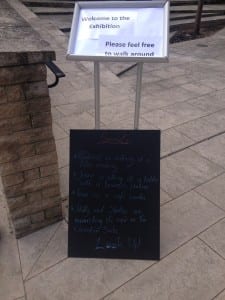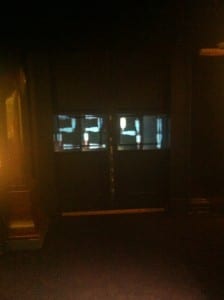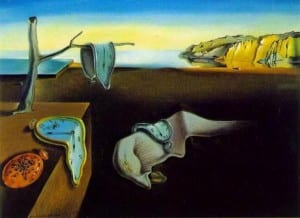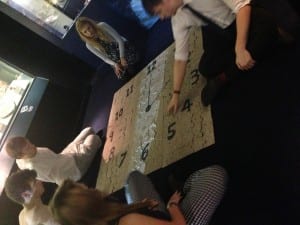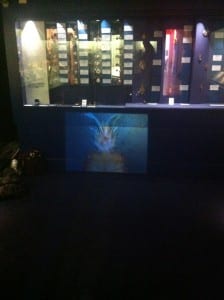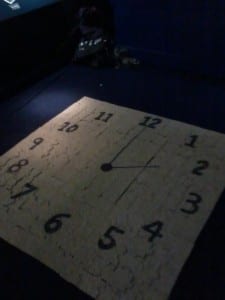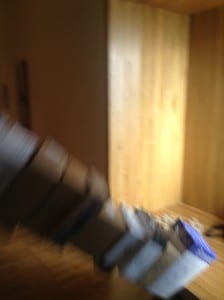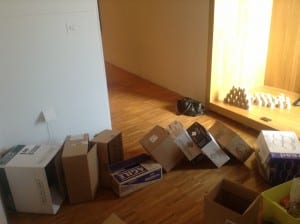Finally, after months of hard work and development our finished piece was performed to the public and overall I am thrilled with the end result. As both director and performer it was a proud moment watching our project come to life in such a beautiful setting and succeed.
Before stepping out of the education room to start our performance I was quite daunted by the prospect of our performance. As we are dealing with site specific work, not all our audience would be expecting us so we were weary as to how the visitors to the Usher Gallery would perceive our piece and if we would just be ignored. Because of this and due to the fact our piece is specific to the gallery and indeed Lincoln, there will in turn be, “A different kind of audience performer interaction” (Pearson, 2010, p9). I wondered how different it would be and even if we would have any audience at all. To our delight however, we drew in quite a large audience over the duration of our piece, with a mixture of expected audience, students and those completely unaware of who we were and why we were there. Although many of the viewers were members of the general public and unaware of our purpose, many still stopped and took time to watch our piece, intrigued as to what we were doing and why. Despite some hanging around the entrance to the room and not entering, some did venture inside and walked around our performance, watching the actions of both us girls and Tom and noting the video on the wall and our scattered photographs.
Over the last few months, our performance has developed so much and has grown in the elements which make up our ending piece but finally we finalised each element, using only the ones which truly benefit our piece and are not too obvious to the audience. Because of this, some elements were taken away and replaced with more developed ideas. The main being the use of sticky labels and applying them to each other as the piece progressed. Although it fitted in with our theme, after trying it out and discussing it with each other and our tutor, we all agreed it was too obvious and didn’t leave much to the imagination. Instead, we experimented with the use of voice clips which would be repeated throughout our performance. We researched tips and guides on how to apply perfect makeup and each of the girls read out a few paragraphs stating different techniques which tell women how to look their best:
“Learning how to apply make up properly is a small investment in time that will help you look your best and boost your self-confidence…the ideal foundation must give you the coverage you need for your skin condition, must perfectly match your skin tone, must perfectly match your undertone.”
We also recorded information and tips on painting techniques which we added to the makeup recordings to create a five minute long sound clip. The two different elements worked really well together and at some points it is uncertain as to whether the tips are aimed at painting or the makeup, backing up how similar the act of applying makeup is to the act of painting. The sound clips fitted in with our performance perfectly and added to the absurdity as the piece progressed. As our audience would be hearing tips on how makeup and paintings should be done, we were performing the complete opposite; Tom hastily sketching our actions without even looking to his paper and us randomly applying makeup without mirrors and no effort in creating the perfect ‘mask’.
The physical part of our performance was also a success, partly due to us having a strict time schedule so we knew how long each part of the process would take. We agreed on spending twenty minutes for the first two times and for our applications to be clinical in the sense of how perfect our makeup would look. The next application we did without a mirror which proved quite difficult. We allowed ourselves fifteen minutes in which to try and get the application as close to perfect as we could but some aspects proved more difficult than others, particularly in getting a smooth application of foundation and trying not to smudge our eyeliner and mascara. After this application however, our process broke down with the application of makeup only lasting five minutes and the makeup becoming messy and unnatural. We also changed position, moving from facing the centre to facing outwards to our audience. It was at this point when more visitors came to watch as they became fascinated seeing us absurdly applying makeup whilst staring out into the space. On our fifth and final application we changed position again, this time becoming even stranger. I laid flat on the floor whilst Sam lay across the seats and Jess slumped against it. This final time we only used foundation and used it to cover our bodies not just our faces. I laid on the floor getting more and more foundation and covered by face, arms and t-shirt with layer upon layer of foundation.
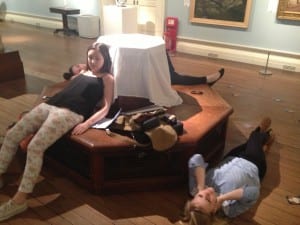 Image from rehearsal, 22/4/2013
Image from rehearsal, 22/4/2013
This surreal image accompanied by the sound of how to apply the perfect makeup, make an impressive final image for our piece and worked well demonstrating our point of how masking isn’t necessarily a positive process. Initially, this was meant to last for five minutes and then the sound of an alarm clock placed in the centre of our podium would ring giving us the signal to leave. However, it turned out that the alarm clock had not been set, meaning this last section lasted for fifteen minutes instead until Sam decided to stand and sound the alarm herself. Although not what we had planned, it worked to our advantage and visually looked more impressive for this process to last longer than we intended. It meant our bodies could become more covered and our application could become more elaborate as we stretched our arms up to cover them in a ritualistic kind of way. To bring our performance to a close, we removed our makeup covered t-shirts and wiped our faces with them for the final time before discarded them on the floor and walked out of the room, leaving traces of our performance behind for people to look at.
Another element of our performance was the video of the Brayford painting we originally based our ideas on. Although no longer with us physically, projecting the image above the Venus de Milo pictures worked well. Using Toms edited image of the Brayford which he changed to look as if more realistic and without the idealised mask it has, the original and newly edited image merge over a twenty minute period to show the difference between the romanticised and ‘real’ image and again reinforce how often both art and society feels the need to fake perfection.
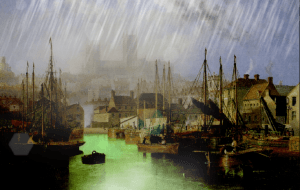 Tom’s edited image, intended to simulate reality rather than romantacising the truth.
Tom’s edited image, intended to simulate reality rather than romantacising the truth.
Overall I am really happy with our end performance and how our rehearsal process developed. We successfully put across our intentions to our audience after feedback from those who watched which is particularly rewarding. Our performance is not a closed one; it is a piece which could be developed even further if given time. It has been a vast learning process and it has been interesting creating a piece which if moved from its initial location, would lose a lot of impact and importance. We hope we have changed the way people view art and people and that perfection can still be achieved without having to create a mask.
Works Cited
Pearson, Mike (2010) Site Specific Performance. UK:Palgrave Macmillan
